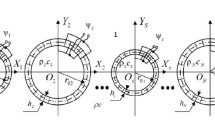Outcomes of the stress state investigations are presented for cylindrical hydroacoustic piezoceramic transducers on their operation in the shielded electroacoustic systems, which is defined by the maximum amplitudes of their vibration velocities and physical parameters of piezoceramic materials. The calculation model of the shield–transducer system takes account of the coupling between the electric, mechanical, and acoustic fields of its piezoceramic transducers in the energy conversion process and of multiple interchange with radiated and reflected acoustic waves between the system elements on the formation of acoustic fields in the environment. For the sector shield–transducer system, the amplitude-frequency characteristics of dynamic stresses in the transducers were established to be quantitatively related to the electrophysical parameters of their piezoceramic materials. In this case, different vibration modes of the system are shown to be possibly excited, which are just responsible for the stress state of transducers. A significant increase in dynamic stresses of the transducers with the natural frequencies of the above vibration modes of the system, much larger as compared to those in isolated transducers, is especially dangerous. It is caused by a series of new resonances due to the interaction of system elements over the acoustic field in the environment as a result of multiple interchange with radiated and reflected acoustic waves. Maximum dynamic stresses are established to be dependent on the arrangement of transducers in the sector of the circular shield–transducer system and their energy conversion efficiency.



Similar content being viewed by others
References
V. V. Bogorodskii (Ed.), Underwater Electroacoustic Transducers. Calculation and Design. Handbook [in Russian], Sudostroenie, Leningrad (1983).
V. T. Grinchenko, A. F. Ulitko, and A. N. Shul’ga, Mechanics of Coupled Fields in Structure Elements [in Russian], Vol. 5: Electroelasticity, Naukova Dumka, Kiev (1989).
V. T. Grinchenko, I. V. Vovk, and V. T. Matsipura, Wave Problems of Acoustics [in Russian], Interservis, Kiev (2013).
O. V. Korzhik and N. Yu. Filipova, “Studies on the electric fields of piezoceramic transducers with a compatible layer,” Zhurn. Nano Electron. Fiz., 9, No. 4, 1–8 (2017).
A. V. Korzhik, T. S. Kuroedova, and N. Yu. Filippova, “Studies on the electromechanical characteristics of a radiating cylindrical piezoceramic transducer with a fully electrode-coated surface,” Elektron. Svyaz., No. 1, 102–109 (2013).
B. Aronov, “Experimental methods for investigating the acoustical interaction between transducers,” J. Acoust. Soc. Am., 119, No. 6, 3822–3830 (2006).
C. H. Sherman and J. L. Butler, Transducers and Arrays for Underwater Sound, Springer, New York (2007).
E. L. Shenderov, Sound Radiation and Dissipation [in Russian], Sudostroenie, Leningrad (1972).
O. Leiko, A. Derepa, O. Pozdniakova, and Y. Starovoit, “Acoustic fields of circular cylindrical hydroacoustic systems with a screen formed from cylindrical piezoceramic radiators,” Rom. J. Acoust. Vib., 15, No. 1, 41–46 (2018).
O. G. Leiko and Ya. I. Starovoit, “Frequency characteristics of electric fields of the cylindrical piezoceramic transducer system with the shield in the inner space,” Zhurn. Nano Electron. Fiz., 8, No. 4, 1–6 (2017).
A. Leiko, A. Derepa, A. Rasstrygin, et al., “Calculations of electric fields of circular screened systems, generated from cylindrical piezoceramic radiators,” Arch. Acoust., 44, No. 1, 129–135 (2019).
A. P. Zin’kovskii, “Distortion of the sinusoidalness of the forms of vibrations systems with a disturbed rotary symmetry and the mode localization phenomenon. Report 1,” Strength Mater., 24, No. 10, 613–620 (1992).
A. Leiko, A. Derepa, I. Averichev, et al., “Mutual influence of electrical, mechanical and acoustic fields under the radiation of sound by circular systems with screen, formed from cylindrical piezoceramic radiators,” in: Interdisciplinary Studies of Complex Systems, Issue 14, Kyiv (2019), pp. 35–52.
Author information
Authors and Affiliations
Corresponding author
Additional information
Translated from Problemy Prochnosti, No. 6, pp. 25 – 35, November – December, 2019.
Rights and permissions
About this article
Cite this article
Chepkov, I.B., Lapitskii, S.V., Zinkovskii, A.P. et al. Resonances in the System of Shield-Coupled Hydroacoustic Piezoceramic Transducers. Strength Mater 51, 834–842 (2019). https://doi.org/10.1007/s11223-020-00134-5
Received:
Published:
Issue Date:
DOI: https://doi.org/10.1007/s11223-020-00134-5




